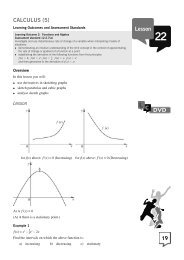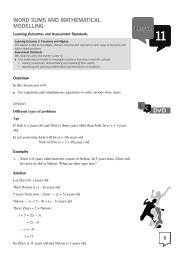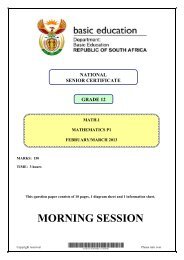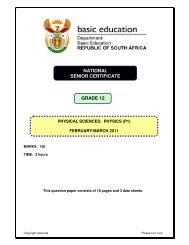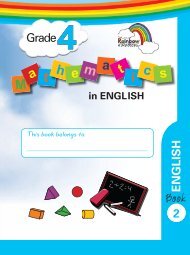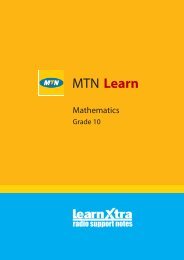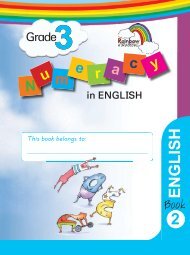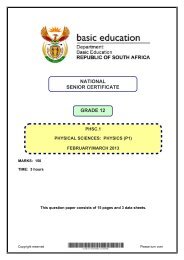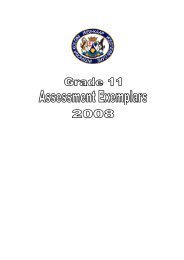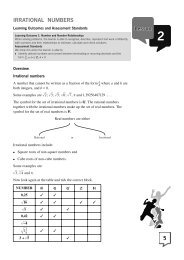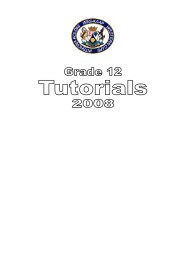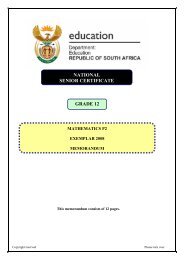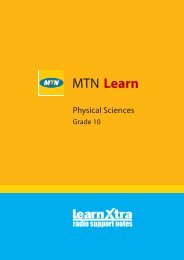Grade 11 Tutorials - Maths Excellence
Grade 11 Tutorials - Maths Excellence
Grade 11 Tutorials - Maths Excellence
Create successful ePaper yourself
Turn your PDF publications into a flip-book with our unique Google optimized e-Paper software.
GRADE <strong>11</strong> TUTORIALS<br />
LO Topic<br />
Page<br />
1 Number patterns and sequences 3<br />
1 Functions and graphs 6<br />
2 Algebra and equations 9<br />
2 Finance <strong>11</strong><br />
2 Linear Programming 15<br />
3 Analytical Geometry 21<br />
3 Transformation 23<br />
3 Trig / Mensuration 27<br />
4 Data handling 31<br />
<strong>Grade</strong> <strong>11</strong> - 2 - <strong>Tutorials</strong>
<strong>Grade</strong> <strong>11</strong> Tutorial<br />
Number Patterns and Sequences<br />
Question 1<br />
Consider the following sequences and in each case:<br />
• Write down the next three terms.<br />
• Make a conjecture about the sequence.<br />
• State whether the general term will be linear, quadratic or neither of the two.<br />
1.1 3 ; 7 ; <strong>11</strong> ; 15 ; 19 ; ……….. 1.2 50 ; 44 ; 38 ; 32 ; 26 ; ……..<br />
1.3 2 ; 3 ; 5 ; 8 ; 13 ; ……….. 1.4 1 ; 2 ; 4 ; 8 ;16 ; ………..<br />
1<br />
1<br />
1.5 2 ; 3<br />
2<br />
; 5 ; 6<br />
2<br />
; 8 ; ……….. 1.6 1 ; 4 ; 9 ; 16 ; 25 ; ………..<br />
1.7 – 27 ; – 22 ; – 17 ; – 12 ; – 7 ; ……….. 1.8 2 ; 6 ; 18 ; 54 ; 162 ; …………<br />
1.9 3 ; 6 ; <strong>11</strong> ; 18 ; 27 ; ………..<br />
1.10 5 + 7x<br />
; 7 + 9x<br />
; 9 + <strong>11</strong>x<br />
; <strong>11</strong>+ 13x<br />
; ………….<br />
Question 2<br />
Consider the following sequences and in each case determine:<br />
• The next three terms.<br />
• A general algebraic formula that you can use to find any term of the sequence.<br />
[Check that your formula works]<br />
2.1 – 4, 1, 6 ; <strong>11</strong> ; 16 ; ................ 2.2 32 ; 16 ; 8 ; 4 ; 2 ; …………..<br />
2.3 3 ; 10 ; 21 ; 36 ; 55 ; …………. 2.4 1 ; 8 ; 27 ; 64 ; 125 ; ……….<br />
2.5 1 ; 3 ; 9 ; 27 ; 81 ; ……………. 2.6 5; <strong>11</strong>; 20 ; 32 ; 47 ; ………….<br />
2.7<br />
1<br />
3<br />
;<br />
2<br />
5<br />
;<br />
3<br />
7<br />
;<br />
4<br />
9<br />
;<br />
5<br />
<strong>11</strong><br />
; ……………<br />
2.8 2 ; 3 ; 5 ; 8 ; 12 ; ……………….<br />
<strong>Grade</strong> <strong>11</strong> - 3 - <strong>Tutorials</strong>
Question 3<br />
Once a year the City of Cape Town hosts a “long table dinner”. Small square tables are arranged next to each<br />
other in a straight row, so that one person sits on each of the available sides of the table. So for example with 2<br />
tables 6 people can be seated and with 4 tables 10 people can be seated.<br />
3.1 If 18 tables are arranged as described above, how many people can be seated?<br />
3.2 How many tables must be packed next to each other if 94 people must be seated?<br />
(Show all calculations).<br />
3.3 How many tables must be packed next to each other if 57 people must be seated?<br />
(Show all calculations).<br />
3.4 Determine an algebraic formula that would generalize the relationship between the number<br />
of tables and the number of people that can be seated.<br />
Question 4<br />
Thabo links balls with rods in arrangements as shown below:<br />
Arrangement 1 Arrangement 2 Arrangement 3 Arrangement 4<br />
1 ball, 4 rods 4 balls, 12 rods 9 balls, 24 rods 16 balls 40 rods<br />
4.1 Determine the number of balls in the nth arrangement.<br />
4.2 Determine the number of rods in the nth arrangement.<br />
<strong>Grade</strong> <strong>11</strong> - 4 - <strong>Tutorials</strong>
Question 5<br />
Dots are arranged to form patterns as shown below:<br />
Pattern 1 Pattern 2 Pattern 3 Pattern 4<br />
5.1 Make a conjecture about the relationship between the number of dots and the Pattern number.<br />
5.2 Write an algebraic formula that generalizes the relationship in 5.1.<br />
Question 6<br />
In each of the following the general term for the sequence is given. Write down the first three terms in each<br />
case.<br />
6.1 T n<br />
= 10 − 4n<br />
6.2 = n 2 + 3<br />
T n<br />
6.3 T n =<br />
2 n−2<br />
6.4 T n = 7.3 n−1<br />
6.5 T n = n 2 – 2n – 3 6.6 T n = – n 2 + n<br />
6.7 T 1 = 5; T n = T n – 1 + 9 6.8 T 1 = 4; T 2 = 6 ; T n = T n – 2 + T n – 1<br />
6.9<br />
T n<br />
2n −1<br />
=<br />
3 n + 1<br />
Question 7<br />
Study the following sequences then:<br />
• Find a formula for the general term (Tn)<br />
• The number of terms in the sequence.<br />
7.1 5 ; 9 ; 13 ; 17 ; 21 ; …… ; 217<br />
7.2 1 : 3 ; 9 ; 27 ; 81 ; …. ; 59049<br />
7.3 10 ;.20 ; 40 ; 80 ; 160 ; ………; 5242880<br />
7.4 3 ; 8 ; 15 ; 24 ; 35 ; ……; 10200<br />
<strong>Grade</strong> <strong>11</strong> - 5 - <strong>Tutorials</strong>
<strong>Grade</strong> <strong>11</strong> Tutorial<br />
Functions and Graphs<br />
Question 1<br />
1.1 Sketch the graph of y = −(<br />
x −1)<br />
2 + 4 , showing the co-ordinates of the turning point and the coordinates<br />
of any intercepts with the axes.<br />
1.2 Write down the equation of<br />
1.2.1 the reflection of y = −(<br />
x −1)<br />
2 + 4 in the y-axis,<br />
1.2.2 the reflection of y = −(<br />
x −1)<br />
2 + 4 in the x-axis and<br />
1.2.3 the graph formed by translating by 1 unit to the right, the graph of y = −(<br />
x −1)<br />
2 + 4 .<br />
1.3 Does the point (−2;<br />
3)<br />
lie on the graph? Why or why not?<br />
Question 2<br />
− x+<br />
p<br />
The functions y = f ( x) = 2 and y = g( x)<br />
= . The graphs intersect at A ( − 1; 4)<br />
y<br />
− x+<br />
p<br />
= f ( x) = 2 on the x -axis is B ( 0 ;2)<br />
q<br />
x<br />
, and the intersection of<br />
^y<br />
A (−1;4)<br />
B (0; 2)<br />
O<br />
C<br />
D<br />
>x<br />
E<br />
2.1 Calculate the values of p and q .<br />
2.2 Write down the domain of = g( x)<br />
y =<br />
− x+<br />
p<br />
2.3 Write down the range of y = f ( x) = 2<br />
− x+<br />
p<br />
2.4 Write down the equation of the asymptote of y f ( x) =<br />
q<br />
x<br />
= 2 .<br />
<strong>Grade</strong> <strong>11</strong> - 6 - <strong>Tutorials</strong>
q<br />
y = = .<br />
x<br />
2.5 Write down the equations of the axes of symmetry of g( x)<br />
2.6 CDE is a line perpendicular to the x -axis. Calculate the distance CE if the distance OD = 2 units.<br />
2.7 Describe in words the difference in the shape and position on a system of axes, of the graphs of<br />
− x<br />
− x<br />
y = 2 , y = 2 . 2 and y = 2 − x + 1<br />
2.8 Calculate the average gradient of each of the graphs in 2.7 between the points where:<br />
2.8.1 x = −1<br />
and x = 0 and<br />
2.8.2 x = 0 and x = 1.<br />
2.9 Do your results in 2.8 support any of the differences you mentioned in 2.7? Why or why not?<br />
Question 3<br />
Sketched below are graphs of p ( x) = 2x<br />
2 − x − 3 and q ( x) = −2 x + 3<br />
D<br />
^y<br />
F<br />
A<br />
G<br />
O<br />
E<br />
>x<br />
H<br />
B<br />
C<br />
3.1 Calculate the distance AB.<br />
3.2 Determine the co-ordinates of C, the turning point of the parabola.<br />
3.3 Calculate the co-ordinates of D and E, the points of intersection of the two graphs.<br />
3.4 Calculate the maximum length of FH between D and E where F lies on the straight line, H lies on the<br />
parabola and FH is parallel to the y -axis.<br />
<strong>Grade</strong> <strong>11</strong> - 7 - <strong>Tutorials</strong>
Question 4<br />
0<br />
On the same system of axes, draw sketch graphs of = tan ( x + 45 )<br />
y and y cos x x .<br />
Show clearly the co-ordinates of all intercepts with the axes, any points of intersection of the two graphs and<br />
draw any asymptotes, indicating the equation/s where applicable.<br />
Question 5<br />
Sketched below is a section of the graphs of f ( x) = a cosbx<br />
and g( x) csin<br />
dx<br />
= for ∈( −135 )<br />
0 ; 45 0<br />
= .<br />
^y<br />
A<br />
(0° ; 1)<br />
O<br />
B<br />
E<br />
>x<br />
C<br />
D<br />
(90 °; −2 )<br />
5.1 Calculate the values of a , b,<br />
c and d .<br />
5.2 What is the period of f ( x) = a cosbx<br />
5.3 What is the range of g( x) = csin<br />
dx<br />
5.4 Calculate the co-ordinates of B, C and E. These points are either intercepts with the x axis turning<br />
points.<br />
0<br />
0<br />
5.5 Determine the value of f ( 45 ) − g( 45 )<br />
<strong>Grade</strong> <strong>11</strong> - 8 - <strong>Tutorials</strong>
<strong>Grade</strong> <strong>11</strong> Tutorial<br />
Algebra and Equations<br />
1. Solve for x : (Leave irrational answers in simplest surd form)<br />
x 1.2 ( x − 7 )( x − 5) = 3<br />
1.1 3 2 −17x + 15 = 0<br />
1.3<br />
1<br />
x = 1+<br />
1.4 x<br />
3 − 2x<br />
2 − x − 2 0<br />
x<br />
=<br />
1.5<br />
2 1<br />
≤<br />
x + 1 x −1<br />
1.6 2x<br />
2 + x > 6<br />
1.7<br />
x 1 3<br />
3 x 1<br />
− ≤ 1.8 ( − 3 ) 2 < 40<br />
−<br />
x<br />
x<br />
1.9 2 = 20<br />
(correct to 3 decimal places) 1.10<br />
x<br />
4 =<br />
2<br />
2<br />
2. Solve for x and y :<br />
2<br />
2<br />
2.1 2 x − y = 5 and x − xy + y + 4 = 0<br />
2.2 xy +12 = 0 and 2 y = x + 10<br />
2<br />
2<br />
2.3 2 x + 3y<br />
= 4 and x − xy − y = −1<br />
3. For which values of k does the straight line y = 2x<br />
+ k touch the hyperbola xy = −18<br />
at<br />
a single point?<br />
4. The product of two positive integers is 160. The difference between them is 27. What are<br />
the numbers?<br />
5. The members of a school photographic club decided to all pay the same amount to buy<br />
new equipment for R1 000. One of the members negotiated a 27,5% discount on the equipment and<br />
the amount that each had to pay was calculated. Then 4 more people joined the club. This meant that<br />
each member had to pay R4 less than was originally announced. How many members were originally in<br />
the club?<br />
6. A trip to a meeting 60 km from home took 5 minutes less than the return trip as the peak<br />
hour traffic reduced the average speed for the return trip by 10 km/h. Calculate the average speed<br />
travelled on the trip to the meeting.<br />
<strong>Grade</strong> <strong>11</strong> - 9 - <strong>Tutorials</strong>
7. Michael throws a stone vertically upwards and after t seconds, its height h , in metres<br />
2<br />
above the ground, is given by h = 80t<br />
− 16t<br />
7.1 At what times was the stone 96 metres above the ground?<br />
7.2 After how many seconds will the stone hit the ground?<br />
7.3 Can the stone ever reach 128 metres?<br />
7.4 What is the maximum height reached by the stone?<br />
8. Two windmills working simultaneously fill a reservoir in 12 hours. The one windmill takes<br />
10 hours longer than the other when one or the other is used on its own. How long does each windmill,<br />
working separately, take to fill the reservoir?<br />
9. A population of insects is diminishing by 20% each week. If the population was estimated<br />
at 1 000 000 initially, in which week will it drop below 1 000?<br />
10. Prove that if a two digit number and the number formed by reversing the digits of<br />
the original number are added, the sum is always divisible by <strong>11</strong>.<br />
For example 43 + 34 = 77 and 77 is divisible by <strong>11</strong>.<br />
<strong>11</strong>. A small plane is flying from A to B with an air velocity of 200 km / h . There is a 50 km / h<br />
wind blowing against the plane, which means the actual velocity of the plane is<br />
150 km / h . Coming back, the wind still has a velocity of 50 km / h and so the actual velocity of the<br />
plane is 250 km / h .<br />
<strong>11</strong>.1 Show that the return trip described above takes longer than it would if there were<br />
no wind and the actual velocity of the plane were 200 km / h both ways.<br />
<strong>11</strong>.2 Show that regardless of the distance travelled and the velocity of the plane and of<br />
the wind, a return trip, against and then with a wind of constant velocity, will always take longer<br />
than the same trip with no wind.<br />
12. Imagine a piece of wire wrapped tightly around the earth along the equator. If the wire<br />
were lengthened by a single metre, it would not fit so tightly. Would a mouse be able to crawl between<br />
the earth and the wire, if the centre of the wire circle was the centre of the earth?<br />
<strong>Grade</strong> <strong>11</strong> - 10 - <strong>Tutorials</strong>
<strong>Grade</strong> <strong>11</strong> Tutorial<br />
Finance<br />
Question 1<br />
1.1 In each of the following, calculate the value of the investment at the end of one year and the total<br />
amount of interest earned.<br />
1.1.1 R12 000 invested at 4,5% per annum simple interest.<br />
1.1.2 R12 000 invested at 4,5% per annum compound.<br />
1.1.3 R12 000 invested at 4,5% per annum compounded monthly.<br />
1.1.4 R12 000 invested at 4,5% per annum compounded quarterly.<br />
1.2 Based on your calculations above, comment on which is type of interest gives the best return on your<br />
investment.<br />
Question 2<br />
Two companies used different methods of calculating the depreciation on capital equipment that they have<br />
purchased.<br />
Company A: The equipment is depreciated at a rate of 8% per annum, calculated on the purchase price of the<br />
item.<br />
Company B: The equipment is depreciated at a rate of 12% per annum, calculated on diminishing balance.<br />
2.1 Both companies bought a printer at the beginning of 2000 for an amount of R8 995. Complete the table<br />
below which shows the depreciated value of the printer at the end of each year. Show all calculations.<br />
A 8275,40<br />
B 7915,60<br />
2000 2001 2002 2003 2004 2005 2006 2007<br />
2.2 The companies write off their assets when the depreciated value is less than 20% of the purchase<br />
price. Determine the book value of the printer when it is ready to be written off.<br />
2.3 During which year will the book value of the printers in both companies be approximately equal?<br />
2.4 Determine the year in which each company will write off the printer.<br />
<strong>Grade</strong> <strong>11</strong> - <strong>11</strong> - <strong>Tutorials</strong>
Question 3<br />
Toby buys a sound system at a cost of R3240,00. He puts down a deposit of 15% and pays the balance<br />
according to a hire purchase agreement paid over two years.<br />
3.1 Calculate the deposit and the outstanding balance after the deposit is paid.<br />
3.2 According the hire purchase agreement, 17% simple interest is calculated on the full outstanding<br />
balance (after the deposit has been paid) for 2 years. Calculate how much Toby will pay in total for the<br />
sound system.<br />
3.3 If Toby pays off what he owes on the sound system in 24 equal monthly installments, how much will he<br />
pay each month.<br />
Question 4<br />
Shaheeda wants to buy an MP3 player. The player that she wants currently costs R1500.<br />
4.1 The MP3 player will increase in cost according to the rate of inflation, which is 6% per annum. How<br />
much will the MP3 player cost in two year’s time?<br />
4.2 Shaheeda puts R400 into her savings account at the beginning of every six month period for two years.<br />
Interest on her savings is paid at 7% per annum, compounded six-monthly. Will she have enough to<br />
pay for the MP3 player at the end of two years? Show all your work.<br />
Question 5<br />
On the day that Clint was born, his grandmother put R10 000 into a savings account for him as a fund to pay for<br />
university or college education. The day before his 18 th birthday, Clint goes to draw money to pay for his<br />
enrollment fees. The balance in the account, before Clint makes a withdrawal, is R41 658.37. What is the<br />
approximate annual compound interest rate earned over the investment period?<br />
Question 6<br />
Calculate approximately how long it will take for an investment of R20 000 to double in the following situations:<br />
(Work correct to a whole compounding period.)<br />
6.1 9,5% interest per annum, compound.<br />
6.2 5,5% simple interest, calculated six monthly.<br />
6.3 8% interest per annum, compounded monthly.<br />
<strong>Grade</strong> <strong>11</strong> - 12 - <strong>Tutorials</strong>
Question 7<br />
R10 000 is invested for a period of two years under different investment conditions. In each case, calculate the<br />
value of the investment at the end of two years and hence determine the effective interest rate, compounded<br />
annually:<br />
7.1 10% per annum, compounded monthly.<br />
7.2 9,5% per annum, compounded daily.<br />
7.3 10,5% simple interest, calculated annually.<br />
Question 8<br />
Talita deposits R15 000 in a savings account. Her money earns 8% per annum interest, compounded quarterly.<br />
At the end of 6 months, Talita deposits another R7 000 into her account and the interest rate changes to 7,5%<br />
per annum, compounded quarterly. Calculate the balance in the account at the end of two years.<br />
Question 9<br />
A pension fund investment of R576 000 earns 8,75% interest per annum, compounded monthly. At the end of<br />
fourteen months, the interest rate changes to 9,25% per annum, compounded monthly and then remains<br />
unchanged for the rest of the investment period, which is 22 months. The investment is withdrawn after a total<br />
of three years.<br />
9.1 Calculate the value of the investment at the end of three years.<br />
9.2 What is the effective annual compound interest rate for the investment over the three year period?<br />
9.3 What is the nominal annual interest rate for the investment smoothed over the period of the<br />
investment?<br />
<strong>Grade</strong> <strong>11</strong> - 13 - <strong>Tutorials</strong>
Question 10<br />
The graph below represents a comparison of investments. In each case, R15 000 was invested for a period of<br />
5 years at an interest rate of 9%.<br />
R 24,000.00<br />
Investment Comparison<br />
R 23,000.00<br />
R 22,000.00<br />
R 21,000.00<br />
Simple Interest<br />
Annual Compound<br />
Quarterly Compound<br />
Daily Compound<br />
Balance (R)<br />
R 20,000.00<br />
R 19,000.00<br />
R 18,000.00<br />
R 17,000.00<br />
R 16,000.00<br />
R 15,000.00<br />
0 1 2 3 4 5<br />
Number of Years<br />
10.1 Is there a significant difference in the investments after 1 year? Justify your answer.<br />
10.2 Which two investments are the most similar?<br />
10.3 If you were advising someone about interest on investments, which interest payment would you advise<br />
him/her to avoid and why?<br />
10.4 Give the equations of each of the lines above, using n to represent the number of years and F to<br />
represent the value of the investment after n years.<br />
<strong>Grade</strong> <strong>11</strong> - 14 - <strong>Tutorials</strong>
<strong>Grade</strong> <strong>11</strong> Tutorial<br />
Linear Programming<br />
Question 1<br />
Use the variables x and y and write down the equation or inequality that represents each of the following<br />
situations. State clearly, in each case, what x and y represent.<br />
1.1 When mixing green paint, the amount of yellow pigment must be at least double the amount<br />
of blue pigment.<br />
1.2 The number of hours spent on <strong>Maths</strong> and English homework each day should not exceed two.<br />
1.3 The sum of two numbers must be greater than 12.<br />
1.4 The profit made on selling an ice cream must be one-and-a-half times the profit made on<br />
selling a chocolate.<br />
1.5 In a hotel, the rooms can accommodate either two people or three people. The total number<br />
of guests in the hotel must be less than 250.<br />
1.6 M is the sum of two numbers.<br />
1.7 M is the sum of one number and double another number.<br />
Question 2<br />
Represent each of the following systems of inequalities graphically:<br />
2.1<br />
x ≤ 15<br />
2.2<br />
− 2 ≤ x ≤ 2<br />
2.3<br />
150x<br />
+ 60y<br />
≤ 30000<br />
y ≤ 12<br />
−1<br />
≤<br />
y ≤ 5<br />
50x<br />
+ 60y<br />
≤ 13000<br />
x + y ≤ 20<br />
2x<br />
+ y ≤ 4<br />
10x<br />
+ 20y<br />
≤ 5000<br />
2.4<br />
x ≤ 200<br />
3x<br />
+ 2y<br />
≤ 2160<br />
5x<br />
+ 2y<br />
≤ 4800<br />
y<br />
x<br />
≥<br />
3<br />
2<br />
<strong>Grade</strong> <strong>11</strong> - 15 - <strong>Tutorials</strong>
Question 3<br />
Represent each of the following systems of graphs symbolically in terms of x and y:<br />
3.1 3.2<br />
300<br />
y<br />
y<br />
250<br />
200<br />
250<br />
200<br />
150<br />
150<br />
100<br />
100<br />
50<br />
50<br />
50 100 150 200 250 300<br />
x<br />
50 100 150 200 250 300<br />
x<br />
Question 4<br />
On the grid provided, draw the graph of 2 y + x = 12 , where x ≥ 0 and y ≥ 0<br />
4.1 Give three ordered pairs that are a<br />
solution to the equation 2 y + x = 12 .<br />
4.2 What is the gradient of the graph?<br />
4.3 State the x and y intercepts of the graph.<br />
4.4 Using a blue pen, shade the region<br />
which represents 2 y + x < 12<br />
4.5 Give three ordered pairs that are a<br />
solution to the equation 2 y + x < 12<br />
<strong>Grade</strong> <strong>11</strong> - 16 - <strong>Tutorials</strong>
Question 5<br />
Nomhle and Shaun are playing a game with dice. There is one red dice and one blue dice. A throw (which is a<br />
throw of both dice) is awarded a point if it meets the following conditions:<br />
• Neither the red nor the blue dice must be 6.<br />
• The number on the red dice must be greater than the number on the blue dice.<br />
• The sum of the numbers of the two dice must not exceed 7.<br />
5.1 If x represents the number on the red dice and y represents the number on the blue dice, set up<br />
equations that represent the rules of the game as given above.<br />
5.2 On graph paper and on the same system of axes, draw the graphs of the equations that you<br />
have set up.<br />
5.3 Using your graphs, list all the throws that for which a point is awarded.<br />
5.4 If two points are awarded for an admissible throw where the sum of the two numbers on the dice<br />
is a maximum, which throws will be awarded two points?<br />
Question 6<br />
At SmoothSmoothies, the SuperSmoothies contain a base of yoghurt and banana. Customers may choose to<br />
add strawberry and melon, subject the following constraints, which have also been expressed mathematically:<br />
Using x to represent the scoops of strawberry and y to represent the scoops of melon, the diagram below<br />
represents the linear constraints in making a SuperSmoothie.<br />
6<br />
a) The added fruit may not exceed six scoops:<br />
( x + y ≤ 6 )<br />
4<br />
b) At least one scoop of each fruit must be added.<br />
( x ≥ 1 and y ≥ 1)<br />
2<br />
5<br />
c) The number of scoops of strawberry may not be<br />
more than double the number of scoops of melon.<br />
( x ≤ 2y<br />
)<br />
d) No fractions of a scoop are allowed. ( x, y ∈ Z )<br />
6.1 Use the letters (a), (b), (c) and (d) to match the constraints to their graphical representation<br />
in the diagram above.<br />
6.2 Write down any implicit constraints or constraints that are not represented in the diagram.<br />
6.3 On the diagram, shade the feasible region.<br />
6.4 What is the maximum number of scoops of strawberry in a SuperSmoothie?<br />
6.5 A customer orders a smoothie with 2 scoops of strawberry and 5 scoops of melon. Explain<br />
to the customer why it is not possible to have this option in a smoothie.<br />
<strong>Grade</strong> <strong>11</strong> - 17 - <strong>Tutorials</strong>
6.6 If the customer wants 3 scoops of melon, how many scoops of strawberry can the customer have?<br />
6.7 If the customer wants six scoops of fruit, but scoops of strawberry are cheaper than scoops of melon,<br />
which is the cheapest option? (i.e. how many scoops of melon and how many scoops of strawberry?)<br />
Question 7<br />
A toy factory makes two different types of wooden toys –coloured blocks (x) and mobiles (y). According to its<br />
worker contracts, the factory guarantees each department a minimum amount of work per day.<br />
The cutting department must have at least 480 minutes of work per day. A set of coloured blocks takes 20<br />
minutes to cut and a mobile takes 10 minutes to cut.<br />
The decorating department must have at least 600 minutes of work per day. A mobile takes 20 minutes to<br />
decorate and a set of wooden blocks take 10 minutes to decorate.<br />
The assembly department must have at least 1080 minutes of work per day. A set of coloured blocks takes 10<br />
minutes to assembly and a mobile takes 60 minutes to assemple.<br />
7. If x represents the number of set of blocks and y represents the number of mobiles, present the<br />
information given above as a set of inequalities.<br />
7.2 On graph paper, graph the set of inequalities and indicate the feasible region.<br />
7.3 If materials for a set of blocks costs R15 and the materials for a mobile cost R45, set up an equation<br />
which represent the cost (C) of producing paint.<br />
7.4 Plot the cost equation on your graph and use it to determine which vertex will result in the most<br />
effective production schedule that minimises costs.<br />
7.5 Find the co-ordinates of this vertex by solving the appropriate two boundary lines.<br />
<strong>Grade</strong> <strong>11</strong> - 18 - <strong>Tutorials</strong>
Question 8<br />
An organic farmer grows lavender and vegetables. He has a plot of land with an area of 9 hectares. In order to<br />
fulfil his market contracts the farmer has to plant at least 2 hectares of lavender and 1 hectare of vegetables. In<br />
order to minimise the damage done by insects, the area under lavender should be at least equal to the area<br />
under vegetables. In order to maintain the nitrogen balance of the soil, the area under lavender should not be<br />
more than double the area under vegetables.<br />
8.1 Below is a system of equations that models the scenario described. If x is the hectares under lavender<br />
and y is the hectares under vegetables, extract from the text the words that have resulted in the<br />
constraint being modelled (i.e. write down the words from the text that belong to each constraint).<br />
8.1.1 x ≥ y<br />
8.1.2 x ≥ 2<br />
8.1.3 x ≤ 2y<br />
8.1.4 x + y ≤ 9<br />
8.1.5 y ≥ 1<br />
8.2 Using graph paper, draw the system of equations and shade the feasible region.<br />
8.3 Set up a Profit equation if the profit on a hectare of lavender is R10 000 and the profit on a<br />
hectare of vegetables is R8 000.<br />
8.4 Graph the profit equation and use it to assist you in determining accurately the planting schedule<br />
that will result in the farmer maximizing profit.<br />
8.5 If the profit margins changed so that the profit on vegetables and lavender were equal, would it be<br />
necessary for the farmer to change his planting schedule? Explain your answer.<br />
Question 9<br />
Creative-cards is a small company that makes two types of cards, Card X and Card Y. With the available labour<br />
and material, the company cannot make more than 150 of Card X and not more than 120 of Card Y per week.<br />
Altogether they cannot make more than 200 cards per week.<br />
There is an order for at least 40 of Card X and 10 of Card Y cards per week.<br />
Creative-cards makes a profit of R5 for each of Card X and R10 for each of Card Y .<br />
Let the number of Card X manufactured per week be x and the number of Card Y manufactured per week be y.<br />
9.1 State all the constraint inequalities that represent the above situation.<br />
9.2 Represent the constraints graphically and shade the feasible region.<br />
9.3 Write the equation that represents the profit P (the objective function), in terms of x and y.<br />
9.4 On your graph, draw a straight line which will help you to determine how many of each type of card<br />
must be made weekly to produce the maximum profit.<br />
9.5 Calculate the maximum weekly profit.<br />
<strong>Grade</strong> <strong>11</strong> - 19 - <strong>Tutorials</strong>
Question 10<br />
Vitamins B and E are vital ingredients of two types of<br />
health drinks, Energex and Vitagex<br />
• You require 3 g of Vitamin B and 4 g of Vitamin E to produce 1 litre of Energex<br />
• You require 9 g of Vitamin B and 6 g of Vitamin E to produce 1 litre of Vitagex<br />
• The company has 27 g of Vitamin B and 30 g of Vitamin E per day<br />
The above information is summarized in the table below:<br />
Ingredients Energex Vitagex Maximum grams<br />
Vitamin B 3 9 27<br />
Vitamin E 4 6 30<br />
• Furthermore at least 3 litres of Energex needs to be produced per day.<br />
Let x and y be the number of litres of Energex and Vitagex respectively that are produced per day.<br />
10.1 State algebraically, in terms of x and y, the constraints that apply to this problem for a day.<br />
10.2 Represent the constraints graphically on the graph paper provided and shade the feasible region.<br />
10.3 If the profit on 1 l of Energex is R30 and the profit on 1 l of Vitagex is R50, express the<br />
profit, P, in terms of x and y.<br />
10.4 Determine, by making use of a searchline, how many litres of each health drink must be<br />
produced in a day to ensure a maximum profit.<br />
10.5 Calculate the maximum possible profit.<br />
<strong>Grade</strong> <strong>11</strong> - 20 - <strong>Tutorials</strong>
<strong>Grade</strong> <strong>11</strong> Tutorial<br />
Analytical Geometry<br />
Question 1<br />
P is the point (5; 2) and Q is the point (3;6). Calculate the:<br />
1.1 length of the line segment PQ (correct to 1 decimal place);<br />
1.2 coordinates of the midpoint M of the line segment PQ;<br />
1.3 equation of the line through P and Q;<br />
1.4 equation of the perpendicular bisector of PQ.<br />
Question 2<br />
In the given sketch, ( − 4;<br />
−1)<br />
A , (1;2 )<br />
B and ( 4;<br />
−3)<br />
C are the vertices of ∆ ABC .<br />
y ^<br />
Β(1; 2 )<br />
α<br />
>x<br />
Α(−4; −1 )<br />
C(4; −3 )<br />
2.1 Show that the triangle is right-angled at B.<br />
2.2 Calculate the size of , the inclination of AB (correct to 1 decimal place).<br />
2.3 Calculate the equation of the line parallel to AC, through the point B<br />
2.4 Calculate the area of ABC ∆ (remember, don’t round off numbers until you get to<br />
your final answer)<br />
<strong>Grade</strong> <strong>11</strong> - 21 - <strong>Tutorials</strong>
Question 3<br />
3.1 Determine the values of x and y if;<br />
3.1.1 (1, 3) is the midpoint of the line segment joining (4, 5) and (x; y)<br />
3.1.2 (-1, y) is the midpoint of the line segment joining (0, -2) and (x; 8)<br />
3.1.3 (x; 3) is the centre of a circle with diameter MN where M is the point (5; -2) and<br />
N is the point (-7: y)<br />
3.2 P(-3: 1), Q(-5: -3) and R(1: -5) are 3 vertices of a triangle.<br />
3.2.1 Find the gradient of QR<br />
3.2.2 Find the equation of the altitude from P to QR.<br />
3.2.3 Find the length of PP’ if P’ is the reflection of P about the line y = x<br />
3.2.4 Find the midpoint of PP’<br />
Question 4<br />
o<br />
The inclination of a line VW is<br />
1;<br />
− 3<br />
1;<br />
− 1 .<br />
Are the lines VW and XY parallel, perpendicular or neither parallel nor perpendicular?<br />
Show all working.<br />
45 . X is the point ( − ) and Y is the point ( )<br />
Question 5<br />
Find the size of<br />
BA<br />
ˆ C<br />
in the figure alongside<br />
y<br />
A ( -2 ; 3 )<br />
B ( 4 ; -1 )<br />
x<br />
C ( -3 ; -2 )<br />
<strong>Grade</strong> <strong>11</strong> - 22 - <strong>Tutorials</strong>
<strong>Grade</strong> <strong>11</strong> Tutorial<br />
Transformation Geometry<br />
Question 1<br />
T<br />
6<br />
y<br />
E<br />
R<br />
S<br />
4<br />
D<br />
C<br />
Q<br />
P<br />
2<br />
A<br />
B<br />
x<br />
-5 5<br />
V<br />
U<br />
-2<br />
W<br />
X<br />
-4<br />
Y<br />
-6<br />
1.1 State the general rule for the coordinates of any point representing the transformation of<br />
polygon ABCDE to polygon PQRST.<br />
1.2 Describe two possible transformations of polygon ABCDE to polygon UVWXY<br />
1.3 Give the coordinates of the reflection of point D in the line y = −x<br />
1.4 Describe the transformation in words if R is mapped to the point R’( 8 ; - 4 )<br />
1.5 Give the coordinates of W’ if W is first rotated<br />
in the y-axis.<br />
o<br />
90 anti-clockwise and then reflected<br />
<strong>Grade</strong> <strong>11</strong> - 23 - <strong>Tutorials</strong>
Question 2<br />
P ( -1 ; 2), Q (2 ; - 1 ) and R ( - 3 ; - 2 ) are the vertices of<br />
∆ PQR .<br />
P<br />
2<br />
y<br />
x<br />
-5<br />
Q<br />
R<br />
-2<br />
2.1 ∆ PQR is to be enlarged by a factor of 2<br />
2.2 ∆PQR<br />
2.1.1 Use the grid on the diagram sheet to draw this enlargement and clearly indicate<br />
the vertices P’Q’R’.<br />
2.1.2 Give the coordinates of vertices P’ and R’ of the enlargement.<br />
2.1.3 If the area of PQR is x square units, determine the area of the enlargement<br />
P’Q’R’.<br />
is rotated<br />
o<br />
90 in an anti-clockwise direction through the origin.<br />
2.2.1 State the general rule for the coordinates of a point satisfying this type of rotation.<br />
2.2.2 Give the coordinates of the vertices of P’’Q’’R’’ for this rotation.<br />
2.2.3 Write down the coordinates of R’’’ if R is reflected in the line x y = and then<br />
translated by the translation (-2 ; 3)<br />
<strong>Grade</strong> <strong>11</strong> - 24 - <strong>Tutorials</strong>
Question 3<br />
P<br />
y<br />
8<br />
6<br />
S<br />
R<br />
Q<br />
4<br />
T<br />
2<br />
-5 5 10<br />
x<br />
-2<br />
-4<br />
-6<br />
-8<br />
U<br />
3.1 Describe the transformation in words that would transform ∆ PQR to ∆ STU<br />
3.2 Give the general rule for the coordinates of any point undergoing this transformation.<br />
3.4 Give the coordinates of S’ if S is transformed in this same manner again.<br />
3.3 Give the coordinates of P’, if P’ is the reflection of P in the line y = −x<br />
3.5 Give the coordinates of S’’, T’’ and U’’ if ∆ STU is translated to ∆ S’’T’’U’’ by the<br />
translation of (-2 ; 3).<br />
3.6 Write down the coordinates of T’’’ if T is reflected about the x-axis and then reflected<br />
about the line y = x .<br />
3.7 Write the coordinates of P’’ if P is translated by the rule ( x + 1; y − 2 ) and is then<br />
reflected about the y axis<br />
<strong>Grade</strong> <strong>11</strong> - 25 - <strong>Tutorials</strong>
Diagram Sheet<br />
Question 2<br />
6<br />
y<br />
4<br />
P<br />
2<br />
x<br />
-5 5<br />
Q<br />
R<br />
-2<br />
-4<br />
-6<br />
<strong>Grade</strong> <strong>11</strong> - 26 - <strong>Tutorials</strong>
<strong>Grade</strong> <strong>11</strong> Tutorial<br />
Trig / Mensuration<br />
Question 1<br />
1.1 In which quadrant does θ lie if:<br />
1.1.1 sin θ < 0 and tan θ < 0<br />
1.1.2 cos θ > 0 and sin θ < 0<br />
1.1.3 tan θ > 0 and cos θ > 0<br />
1.2 If<br />
2<br />
cosθ = − and 180° ≤ θ ≤ 360°<br />
, use a sketch to determine the value of:<br />
13<br />
1.2.1 tan θ<br />
1.2.2 sin θ cosθ<br />
1.3 If tan θ = t and θ is acute, determine sin θ in terms of t.<br />
Question 2<br />
2.1 If x = 87, 6°<br />
and y = 240, 2°<br />
, use a calculator to evaluate each of the following correct to two decimal<br />
places:<br />
2.1.1 cos( x + y)<br />
2.1.2<br />
2<br />
sin( 2x<br />
− y)<br />
+ tan x<br />
sin y<br />
2.1.3 + 3tan 2x<br />
2.1.4<br />
cos x<br />
cos y<br />
2<br />
2.2 Without using a calculator, find the value of:<br />
2.2.1 tan 30° .sin 60°<br />
2.2.2 cos 2 45° + sin 30°<br />
2.2.3 cos 30° + sin 60°<br />
Question 3<br />
3.1 Reduce each of the following to a trigonometric ratio of x:<br />
3.1.1 sin( 180° + x)<br />
3.1.2 tan( 90°<br />
+ x)<br />
3.1.3 cos( 360° − x)<br />
3.1.4<br />
cos(90° − x)<br />
sin(360° − x)<br />
3.1.5 sin x − cos(90° − x)<br />
− tan(180°<br />
− x)<br />
<strong>Grade</strong> <strong>11</strong> - 27 - <strong>Tutorials</strong>
3.2 Evaluate without using a calculator:<br />
3.2.1 tan 120°<br />
3.2.2 cos 630°<br />
3.2.3 sin 150° + tan 330°<br />
.cos30°<br />
3.2.4<br />
1<br />
3.3 Prove that: sin 240°<br />
tan 300° + cos330°<br />
= ( 3 + 3)<br />
Question 4<br />
4.1 Use basic trigonometric identities to simplify the following:<br />
2<br />
tan 315° + cos300°<br />
sin150° + tan135°<br />
2 2<br />
2 2<br />
4.1.1 tan y.<br />
cos y<br />
4.1.2 tan y sin y + tan y cos y<br />
4.1.3<br />
2<br />
1−<br />
cos y<br />
sin y<br />
4.2 Prove the following identities:<br />
2<br />
sin x<br />
4.2.1 1− = cos x 4.2.2<br />
1+<br />
cos x<br />
cos x<br />
+ tan x =<br />
1+<br />
sin x<br />
1<br />
cos<br />
x<br />
Question 5<br />
Find the general solution to the following equations. Give answers correct to two decimal places:<br />
5.1 sin θ = 0, 515<br />
5.2 3 − tanθ<br />
= 2, 4<br />
5.3 cos( θ + 20°<br />
) = −0,<br />
242<br />
5.4 2 sin( θ −15°<br />
) + 1 = 0<br />
5.5 cos 2θ<br />
= tan 24°<br />
Question 6<br />
On the same system of axes, draw sketch graphs of:<br />
f ( x)<br />
= sin x and g ( x)<br />
= cos(90°<br />
+ x)<br />
for the interval −180°<br />
≤ x ≤ 180°<br />
. Use the graphs to answer the<br />
following questions.<br />
6.1 Describe g (x)<br />
in terms of a reflection of f (x).<br />
6.2 Explain why f ( x)<br />
+ g(<br />
x)<br />
= 0 for all values of x.<br />
<strong>Grade</strong> <strong>11</strong> - 28 - <strong>Tutorials</strong>
B<br />
Question 7<br />
68 o<br />
Refer to the diagram.<br />
7.1 Calculate the measurement of AB (correct to two<br />
decimal places.<br />
41 o<br />
C<br />
7.2 Calculate the area of the triangle.<br />
A<br />
<strong>11</strong>,2cm<br />
Question 8<br />
Refer to the diagram.<br />
8.1 Calculate the length of BC.<br />
8,5cm<br />
B<br />
8.2 Calculate the size of angle B.<br />
A<br />
17 o<br />
14,2cm<br />
C<br />
Question 9<br />
A surveyor is calculating the width of a river that is to have a<br />
bridge built across it. He takes measurements as follows:<br />
The distance from point P to point Q, on the same side of the<br />
river, is 64 metres. R P ˆQ = 62, 4°<br />
, B P ˆQ = 32, 1°<br />
and<br />
ˆQ = 59, 3°<br />
Calculate the width of the river.<br />
P<br />
R<br />
river<br />
32,1 o 62,4 o 64m<br />
59,3 o<br />
B<br />
Q<br />
<strong>Grade</strong> <strong>11</strong> - 29 - <strong>Tutorials</strong>
Question 10<br />
In ∆ FGH , I is a point on FH. G HI ˆ = a,<br />
FGI ˆ = b ,<br />
GH = f and FG = h .<br />
F<br />
Show that:<br />
10.1<br />
sin H<br />
=<br />
hsin(<br />
a − b)<br />
f<br />
h<br />
I<br />
a<br />
10.2<br />
GI<br />
=<br />
hsin( a − b)<br />
sin a<br />
b<br />
10.3<br />
Area ∆ FGI<br />
=<br />
h<br />
2<br />
sin( a − b)sin<br />
b<br />
2sin a<br />
G<br />
f<br />
H<br />
<strong>Grade</strong> <strong>11</strong> - 30 - <strong>Tutorials</strong>
<strong>Grade</strong> <strong>11</strong> Tutorial<br />
Data Handling<br />
Question 1<br />
Fifteen households were surveyed in Saldanha, Oudtshoorn and Stellenbosch with regard to the monthly<br />
amount spent on electricity. The results are recorded in the table below:<br />
Saldanha Oudtshoorn Stellenbosch<br />
R 52.00 R 103.00 R 246.00<br />
R <strong>11</strong>2.00 R 92.00 R 126.00<br />
R 83.00 R 67.00 R 226.00<br />
R 256.00 R 140.00 R 101.00<br />
R 412.00 R 136.00 R 92.00<br />
R 61.00 R 183.00 R 67.00<br />
R 54.00 R 214.00 R 63.00<br />
R 81.00 R 87.00 R 71.00<br />
R 147.00 R 145.00 R 167.00<br />
R 134.00 R 135.00 R 129.00<br />
R 61.00 R 164.00 R <strong>11</strong>7.00<br />
R 78.00 R 103.00 R 135.00<br />
R 225.00 R 129.00 R 129.00<br />
R 23.00 R 152.00 R 168.00<br />
R 189.00 R <strong>11</strong>8.00 R 131.00<br />
1.1 Calculate the following for each of the municipalities:<br />
1.1.1 The mean<br />
1.1.2 The median<br />
1.2 Comment on how these measures are similar or vary in<br />
the three sets of data.<br />
1.3 Explain why the mode is not a suitable measure to<br />
describe any of the sets of data.<br />
1.4 Calculate the following for each of the municipalities:<br />
1.4.1 The maximum value<br />
1.4.2 The minimum value<br />
1.4.3 The range<br />
1.4.4 The upper quartile<br />
1.4.5 The lower quartile<br />
1.4.6 The interquartile range<br />
1.5 Using the 5 number summary for each of the sets of data, draw box and whisker diagrams for<br />
each of the municipalities. Use the grid provided below:<br />
0 50 100 150 200 250 300 350 450 500<br />
<strong>Grade</strong> <strong>11</strong> - 31 - <strong>Tutorials</strong>
1.6 Using the any of the statistical measurements you have calculated, as well as the box and whisker<br />
diagrams, write a short paragraph comparing the household expenditure on electricity in Saldanha,<br />
Oudtshoorn and Stellenbosch.<br />
1.7 The table below gives grouped data for the household electricity expenditure in Saldanha, Oudtshoorn<br />
and Stellenbosch.<br />
Expenditure in R<br />
Number of households<br />
Saldanha Oudtshoorn Stellenbosch<br />
Question 2<br />
A group of people were surveyed with respect to how long it took them to travel to work each day. The results<br />
of the survey is summarized in the chart below.<br />
Time taken to travel to work<br />
2.1 What is the range?<br />
Number of people<br />
450<br />
400<br />
350<br />
300<br />
250<br />
200<br />
150<br />
100<br />
2.2 What is the modal class?<br />
2.3 Which class contains the<br />
median?<br />
2.4 Calculate the estimated<br />
mean. Show your<br />
calculations and work<br />
correct to the nearest<br />
minute.<br />
50<br />
0<br />
0 - 14 minutes<br />
15 - 29 minutes<br />
30 - 44 minutes<br />
45 - 59 minutes<br />
60 - 74 minutes<br />
75 - 89 minutes<br />
90 - 104minutes<br />
105 - <strong>11</strong>9<br />
minutes<br />
120 - 134<br />
minutes<br />
Time (minutes)<br />
Question 3<br />
Oudtshoorn<br />
Oudtshoorn Monthly<br />
Monthly Electricity<br />
Household Income (R)<br />
Expenditure (R)<br />
R 5,534.00 R 92.00<br />
R 5,886.00 R 103.00<br />
R 6,231.00 R 107.00<br />
R 6,671.00 R 139.00<br />
R 7,004.00 R <strong>11</strong>8.00<br />
R 7,421.00 R 135.00<br />
R 7,821.00 R 140.00<br />
R 7,974.00 R 145.00<br />
R 8,023.00 R 146.00<br />
R 8,368.00 R 164.00<br />
R 8,541.00 R 152.00<br />
R 8,718.00 R 168.00<br />
R 9,687.00 R 177.00<br />
R 10,355.00 R 183.00<br />
R 12,076.00 R 214.00<br />
The table alongside gives the monthly household income<br />
and monthly electricity expenditure for 15 families in<br />
Oudsthoorn.<br />
3.1 Calculate the mean monthly household income.<br />
<strong>Grade</strong> <strong>11</strong> - 33 - <strong>Tutorials</strong>
3.2 Complete the table below and then<br />
calculate the standard deviation of the<br />
monthly household income.<br />
3.3 Calculate the percentage household<br />
incomes that fall within one standard<br />
deviation of the mean.<br />
3.4 Use the data in the table at the beginning of<br />
question 2 to draw a scatterplot of monthly<br />
household income against monthly<br />
electricity expenditure.<br />
Question 4<br />
3.4.1 Draw a line of best fit on your<br />
graph.<br />
3.4.2 Is the relationship between<br />
household income linear or<br />
exponential? Justify your answer.<br />
3.4.3 Use your graph to predict the<br />
electricity expenditure in a<br />
household with an income of R3500<br />
per month.<br />
3.4.4 The electricity supplier has<br />
requested that residents in Saldanha cut their electricity consumption by 10%. Assuming the<br />
residents cooperate with this request, how will the line of best fit be affected?<br />
The housing department recently conducted a survey on the number of bedrooms in 200 houses in Saldanha.<br />
The following data was obtained:<br />
No. of bedrooms 1 2 3 4 5 6 7 8 9 10<br />
No. of houses 25 40 42 28 22 18 12 7 4 2<br />
4.1 Set up a cumulative frequency table for the given data.<br />
4.2 Hence draw an ogive (cumulative frequency graph) for this data.<br />
4.3 Use the ogive to determine the median, lower quartile (Q1) and upper quartile (Q3).<br />
4.4 Draw a box and whisker diagram for this data.<br />
4.5 What is the value of the interquartile and semi-interquartile range?<br />
Income (R) ( x i<br />
− x)<br />
R 5,534.00<br />
R 5,886.00<br />
R 6,231.00<br />
R 6,671.00<br />
R 7,004.00<br />
R 7,421.00<br />
R 7,821.00<br />
R 7,974.00<br />
R 8,023.00<br />
R 8,368.00<br />
R 8,541.00<br />
R 8,718.00<br />
R 9,687.00<br />
R 10,355.00<br />
R 12,076.00<br />
n<br />
∑<br />
i=<br />
1<br />
( x i<br />
− x)<br />
2<br />
2<br />
( x i<br />
− x)<br />
<strong>Grade</strong> <strong>11</strong> - 34 - <strong>Tutorials</strong>
Question 5<br />
The monthly household income for families in Oudtshoorn is represented in the graph below.<br />
3 sd<br />
2 sd<br />
1 sd<br />
R2600<br />
1 sd 2 sd 3 sd<br />
The results suggest that the household income is symmetrically distributed with a mean of R2600 per month<br />
and a standard deviation of R950 per month. Research has suggested that if the monthly household income is<br />
below R1650 the family’s income would be deemed to be below the poverty line.<br />
It is also known that :<br />
68% of the monthly household income recorded is within one standard deviation of the mean: 34% above and<br />
34% below;<br />
96% are within two standard deviations of the mean: 48% above and 48% below ;<br />
100% are within three standard deviations of the mean: 50% above and 50% below.<br />
Estimate the percentage of families:<br />
5.1 Whose income is below the poverty line<br />
5.2 Earning more than R3550 per month<br />
5.3 Earning less than R700 per month.<br />
<strong>Grade</strong> <strong>11</strong> - 35 - <strong>Tutorials</strong>



